-
The Dance Class
-
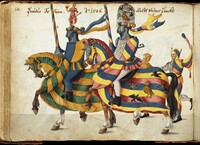 Album of Tournaments and Parades in Nuremberg
Album of Tournaments and Parades in Nuremberg An illustration of a German parade. Two men astride horses are decorated with ornate armor and brightly colored fabrics. Small birds fly around them and two other individuals dressed in brightly colored, comical garments follow closely behind the men on horseback. This illustration is one of 112 in a manuscript which captured Renaissance ceremonial and tournament dress.
-
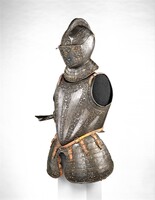 Portions of a Parade Armor
Portions of a Parade Armor The helmet, front plate, back plate, and tassets of a suit of parade armor. The silver armor is decorated with high-relief etchings of scenes and floral motifs. The high-relief decorations would have made this armor unfit for battle and ideal for ceremony.
-
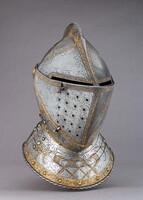 Close Helmet from a Garniture Made for a Member of the d'Avalos Family
Close Helmet from a Garniture Made for a Member of the d'Avalos Family A helmet which was once a part of a field armor garniture. The piece is decorated by significant floral motif etchings, and gilded segments. The proper right side of the visor includes several holes, likely for ventilation during use.
-
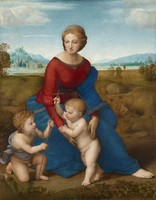 Madonna of the Meadow
Madonna of the Meadow A painting of the Virgin Mary with John the Baptist and Jesus as toddlers playing around her. The background features an idyllic countryside scene. The bodies of the three figures form a triangle, a common reference in Renaissance art to the Holy Trinity.
-
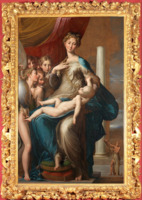 Madonna and Child with Angels (Madonna with the long neck)
Madonna and Child with Angels (Madonna with the long neck) A painting of the Virgin Mary with the nude Christ Child on her lap. Several adolescent angels stand to the left of the seated figures, and a small figure stands to their right. The scene takes place in a visually unfinished room as a pillar stands unconnected to the ceiling, and the wall behind them features a unfinished mural.
-
 Joce Dolezal
Joce Dolezal Image of Joce Dolezal
-
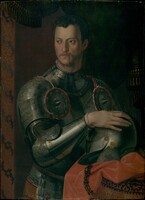 Cosimo I de' Medici (1519–1574)
Cosimo I de' Medici (1519–1574) A painted portrait of Cosimo I de' Medici proudly clothed in armor. The armor is silver and is decorated with red fabric and gold ornaments. The background behind Cosimo I de' Medici is dark, but still visible are large, sumptuous fabrics.
-
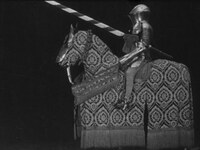 A Visit to the Armor Galleries, 1924
A Visit to the Armor Galleries, 1924 A section of a silent and black and white video created by the The Metropolitan Museum of Art. This portion of the video displays the technical ingenuity of a 16th century suit of armor by displaying its ample mobility.
-
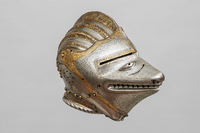 Closed helmet; Fox Helmet
Closed helmet; Fox Helmet Silver close helmet with visor shaped to represent the face of a fox. The fox features include its eyes, nose, mouth, teeth, and small engraved details to mimic fur. The helmet is largely silver but decorated with sections of gold, as well as engraved with floral motifs.
-
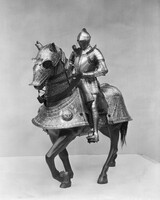 Horse Armor Made for Johann Ernst, Duke of Saxony-Coburg (1521–1553)
Horse Armor Made for Johann Ernst, Duke of Saxony-Coburg (1521–1553) Black and white photo of a 16th century suit of armor staged atop staged elaborately etched bard armor. The armorer Kunz Lochner was one of the few accomplished armorers of the mid sixteenth century.
-
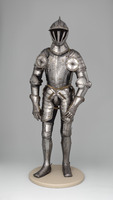 Armor of Emperor Ferdinand I (1503–1564)
Armor of Emperor Ferdinand I (1503–1564) An engraved scene of the Virgin Mary and Christ Child on the breastplate of Ferdinand I. Surrounding the Virgin and Child are engraved illustrations of angelic beings and flower motifs. Circular gold ornaments can be seen across the piece. This breastplate is part of a full suit of armor.
-
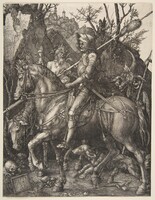 Knight, Death, and the Devil
Knight, Death, and the Devil An engraving by Albrecht Dürer representing the expected moral virtue of a knight. In this engraving, the knight can be seen riding steadfastly past Death who sits atop a pale horse and holds an hourglass. Beside death stands the long-haired, pig-snouted Devil. The landscape that surrounds them features mainly the naked branches of dead trees, and the tall walls of a valley. This knight stands to embody the ideal Christian knight who succeeds in disregarding both Death and the evils of the Devil, illustrating the interconnected nature of knighthood and the Christian faith in the 16th century.
-
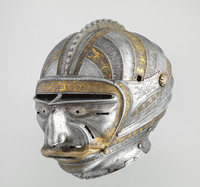 Close Helmet with Mask Visor in Form of a Human Face
Close Helmet with Mask Visor in Form of a Human Face A helmet featuring a grotesque mask visor with dramatic protruding human features. Gold accents and etchings of mystical creatures and flower motifs decorate the piece.
-
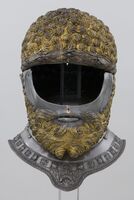 Emperor Charles V's parrying game
Emperor Charles V's parrying game A helmet made by the famous armorer Filippo Negroli. The piece features golden details of curled hair, a large beard, and a wreath atop the head. These details are believed to have been included to purposefully evoke the appearance of an ancient Roman emperor or hero.
-
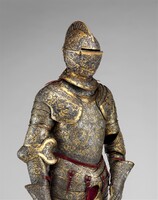 Armor of Henry II, King of France (reigned 1547–59)
Armor of Henry II, King of France (reigned 1547–59) One of the most elaborate complete parade armors. The body of the armor is gold while incorporated across the surface are silver decorations of humans, the grotesque, and floral motifs. These non-human details align the piece with the French Mannerist movement.
-
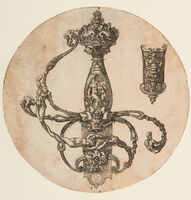 Design for a Rapier Hilt and Scabbard Chape
Design for a Rapier Hilt and Scabbard Chape An etched design for a sword's hilt and scabbard chape made by the prolific goldsmith and engraver Pierre Woeiriot. These highly ornate features include both grotesques and twisted human figures, reflecting its French Mannerist influences.
-
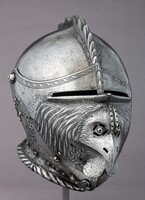 Armet with Mask Visor in the Form of a Rooster
Armet with Mask Visor in the Form of a Rooster A silver helmet fashioned with the protruding features of a rooster's head and wattles from the mask visor. The helmet is also decorated with engraved floral motifs and a small number of gold, circular ornaments.
-
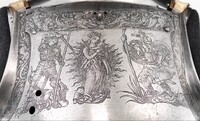 Cuirass and Tassets (Torso and Hip Defense)
Cuirass and Tassets (Torso and Hip Defense) Three of the etchings found on the breastplate of a German cuirass piece. The figures found on this breastplate are Saint George, the Virgin Mary and Christ Child, and Saint Christopher. On the backplate of this cuirass are etchings of Saint James the Great, the Virgin holding Saint Anne and the Christ Child, and Saint Sebastian.
-
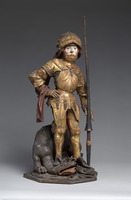 Saint George and the Dragon
Saint George and the Dragon Statue of Saint George, patron saint of knights. Saint George, adorned in full body armor, stands with his foot on the neck of a slayed dragon. The Saint's golden suit of armor stands brightly against the dragon's grey skin. This statue references a thirteenth century legend of the saint saving a Libyan town by singlehandedly defeating a dragon.
-
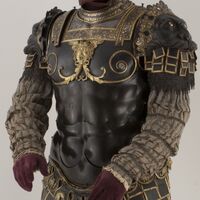 Roman-style armor of Guiobaldo della Rovere, Duke of Urbino, gifted to Philip II
Roman-style armor of Guiobaldo della Rovere, Duke of Urbino, gifted to Philip II A Renaissance cuirass fashioned in the shape of articulated musculature, aligning the piece with armor all'antica . The black metal of the cuirass is decorated with a number of gold ornaments which surround the upper chest. A female face frozen in anguish sits at the center of the chest, golden tendrils expanding from it and circling the faux nipples. The shoulder pieces are fashioned into male faces, from whose mouth descends rectangular hanging attachments. Continuing from these shoulder pieces are fabric sleeves.
-
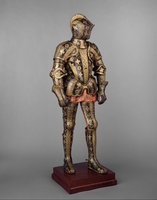 Armor Garniture of George Clifford (1558–1605), Third Earl of Cumberland
Armor Garniture of George Clifford (1558–1605), Third Earl of Cumberland Field and tournament armor made under the direction of Jacob Halder, a master armorer at the royal workshops at Greenwich. The decoration of this suit-of-armor is organized within vertical lines that span from its top to bottom. These decorations are highly symbolic, made up of the Tudor rose, the French Fleur-de-lis, and two E's back to back representing the cipher of Elizabeth.
-
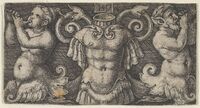 Horizontal Panel with Armour at Center, Flanked by Two Tritons Playing the Horn
Horizontal Panel with Armour at Center, Flanked by Two Tritons Playing the Horn A black and white engraving of a disembodied Roman-style (all'antica) cuirass piece flanked by two triton figures, one male one female, both playing the horn.
-
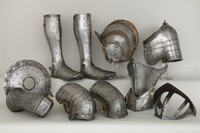 Elements of an Armor Garniture
Elements of an Armor Garniture Ten separated elements of an armor garniture. The pieces that make up this garniture are a helmet, face guard with umbril, reenforcing umbril, shoulder defense, two leg defense pieces, gauntlet, and vamplate. Each piece is silver with tarnished gold decor and engraved floral motifs.
-
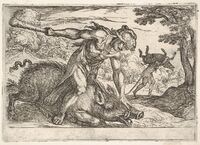 Hercules and the Boar of Erymanthus
Hercules and the Boar of Erymanthus An etching of the legend of Hercules and the Boar of Erymanthus. In the foreground of this etching is Hercules forcefully holding down the Boar of Erymanthus. In the middle ground Hercules is pictured carrying the boar off on his shoulders. In both foreground and middle ground, the head and pelt of the Nemean Lion rests on Hercules' head and drapes down his back.
 Album of Tournaments and Parades in Nuremberg An illustration of a German parade. Two men astride horses are decorated with ornate armor and brightly colored fabrics. Small birds fly around them and two other individuals dressed in brightly colored, comical garments follow closely behind the men on horseback. This illustration is one of 112 in a manuscript which captured Renaissance ceremonial and tournament dress.
Album of Tournaments and Parades in Nuremberg An illustration of a German parade. Two men astride horses are decorated with ornate armor and brightly colored fabrics. Small birds fly around them and two other individuals dressed in brightly colored, comical garments follow closely behind the men on horseback. This illustration is one of 112 in a manuscript which captured Renaissance ceremonial and tournament dress. Portions of a Parade Armor The helmet, front plate, back plate, and tassets of a suit of parade armor. The silver armor is decorated with high-relief etchings of scenes and floral motifs. The high-relief decorations would have made this armor unfit for battle and ideal for ceremony.
Portions of a Parade Armor The helmet, front plate, back plate, and tassets of a suit of parade armor. The silver armor is decorated with high-relief etchings of scenes and floral motifs. The high-relief decorations would have made this armor unfit for battle and ideal for ceremony. Close Helmet from a Garniture Made for a Member of the d'Avalos Family A helmet which was once a part of a field armor garniture. The piece is decorated by significant floral motif etchings, and gilded segments. The proper right side of the visor includes several holes, likely for ventilation during use.
Close Helmet from a Garniture Made for a Member of the d'Avalos Family A helmet which was once a part of a field armor garniture. The piece is decorated by significant floral motif etchings, and gilded segments. The proper right side of the visor includes several holes, likely for ventilation during use. Madonna of the Meadow A painting of the Virgin Mary with John the Baptist and Jesus as toddlers playing around her. The background features an idyllic countryside scene. The bodies of the three figures form a triangle, a common reference in Renaissance art to the Holy Trinity.
Madonna of the Meadow A painting of the Virgin Mary with John the Baptist and Jesus as toddlers playing around her. The background features an idyllic countryside scene. The bodies of the three figures form a triangle, a common reference in Renaissance art to the Holy Trinity. Madonna and Child with Angels (Madonna with the long neck) A painting of the Virgin Mary with the nude Christ Child on her lap. Several adolescent angels stand to the left of the seated figures, and a small figure stands to their right. The scene takes place in a visually unfinished room as a pillar stands unconnected to the ceiling, and the wall behind them features a unfinished mural.
Madonna and Child with Angels (Madonna with the long neck) A painting of the Virgin Mary with the nude Christ Child on her lap. Several adolescent angels stand to the left of the seated figures, and a small figure stands to their right. The scene takes place in a visually unfinished room as a pillar stands unconnected to the ceiling, and the wall behind them features a unfinished mural. Joce Dolezal Image of Joce Dolezal
Joce Dolezal Image of Joce Dolezal Cosimo I de' Medici (1519–1574) A painted portrait of Cosimo I de' Medici proudly clothed in armor. The armor is silver and is decorated with red fabric and gold ornaments. The background behind Cosimo I de' Medici is dark, but still visible are large, sumptuous fabrics.
Cosimo I de' Medici (1519–1574) A painted portrait of Cosimo I de' Medici proudly clothed in armor. The armor is silver and is decorated with red fabric and gold ornaments. The background behind Cosimo I de' Medici is dark, but still visible are large, sumptuous fabrics. A Visit to the Armor Galleries, 1924 A section of a silent and black and white video created by the The Metropolitan Museum of Art. This portion of the video displays the technical ingenuity of a 16th century suit of armor by displaying its ample mobility.
A Visit to the Armor Galleries, 1924 A section of a silent and black and white video created by the The Metropolitan Museum of Art. This portion of the video displays the technical ingenuity of a 16th century suit of armor by displaying its ample mobility. Closed helmet; Fox Helmet Silver close helmet with visor shaped to represent the face of a fox. The fox features include its eyes, nose, mouth, teeth, and small engraved details to mimic fur. The helmet is largely silver but decorated with sections of gold, as well as engraved with floral motifs.
Closed helmet; Fox Helmet Silver close helmet with visor shaped to represent the face of a fox. The fox features include its eyes, nose, mouth, teeth, and small engraved details to mimic fur. The helmet is largely silver but decorated with sections of gold, as well as engraved with floral motifs. Horse Armor Made for Johann Ernst, Duke of Saxony-Coburg (1521–1553) Black and white photo of a 16th century suit of armor staged atop staged elaborately etched bard armor. The armorer Kunz Lochner was one of the few accomplished armorers of the mid sixteenth century.
Horse Armor Made for Johann Ernst, Duke of Saxony-Coburg (1521–1553) Black and white photo of a 16th century suit of armor staged atop staged elaborately etched bard armor. The armorer Kunz Lochner was one of the few accomplished armorers of the mid sixteenth century. Armor of Emperor Ferdinand I (1503–1564) An engraved scene of the Virgin Mary and Christ Child on the breastplate of Ferdinand I. Surrounding the Virgin and Child are engraved illustrations of angelic beings and flower motifs. Circular gold ornaments can be seen across the piece. This breastplate is part of a full suit of armor.
Armor of Emperor Ferdinand I (1503–1564) An engraved scene of the Virgin Mary and Christ Child on the breastplate of Ferdinand I. Surrounding the Virgin and Child are engraved illustrations of angelic beings and flower motifs. Circular gold ornaments can be seen across the piece. This breastplate is part of a full suit of armor. Knight, Death, and the Devil An engraving by Albrecht Dürer representing the expected moral virtue of a knight. In this engraving, the knight can be seen riding steadfastly past Death who sits atop a pale horse and holds an hourglass. Beside death stands the long-haired, pig-snouted Devil. The landscape that surrounds them features mainly the naked branches of dead trees, and the tall walls of a valley. This knight stands to embody the ideal Christian knight who succeeds in disregarding both Death and the evils of the Devil, illustrating the interconnected nature of knighthood and the Christian faith in the 16th century.
Knight, Death, and the Devil An engraving by Albrecht Dürer representing the expected moral virtue of a knight. In this engraving, the knight can be seen riding steadfastly past Death who sits atop a pale horse and holds an hourglass. Beside death stands the long-haired, pig-snouted Devil. The landscape that surrounds them features mainly the naked branches of dead trees, and the tall walls of a valley. This knight stands to embody the ideal Christian knight who succeeds in disregarding both Death and the evils of the Devil, illustrating the interconnected nature of knighthood and the Christian faith in the 16th century. Close Helmet with Mask Visor in Form of a Human Face A helmet featuring a grotesque mask visor with dramatic protruding human features. Gold accents and etchings of mystical creatures and flower motifs decorate the piece.
Close Helmet with Mask Visor in Form of a Human Face A helmet featuring a grotesque mask visor with dramatic protruding human features. Gold accents and etchings of mystical creatures and flower motifs decorate the piece. Emperor Charles V's parrying game A helmet made by the famous armorer Filippo Negroli. The piece features golden details of curled hair, a large beard, and a wreath atop the head. These details are believed to have been included to purposefully evoke the appearance of an ancient Roman emperor or hero.
Emperor Charles V's parrying game A helmet made by the famous armorer Filippo Negroli. The piece features golden details of curled hair, a large beard, and a wreath atop the head. These details are believed to have been included to purposefully evoke the appearance of an ancient Roman emperor or hero. Armor of Henry II, King of France (reigned 1547–59) One of the most elaborate complete parade armors. The body of the armor is gold while incorporated across the surface are silver decorations of humans, the grotesque, and floral motifs. These non-human details align the piece with the French Mannerist movement.
Armor of Henry II, King of France (reigned 1547–59) One of the most elaborate complete parade armors. The body of the armor is gold while incorporated across the surface are silver decorations of humans, the grotesque, and floral motifs. These non-human details align the piece with the French Mannerist movement. Design for a Rapier Hilt and Scabbard Chape An etched design for a sword's hilt and scabbard chape made by the prolific goldsmith and engraver Pierre Woeiriot. These highly ornate features include both grotesques and twisted human figures, reflecting its French Mannerist influences.
Design for a Rapier Hilt and Scabbard Chape An etched design for a sword's hilt and scabbard chape made by the prolific goldsmith and engraver Pierre Woeiriot. These highly ornate features include both grotesques and twisted human figures, reflecting its French Mannerist influences. Armet with Mask Visor in the Form of a Rooster A silver helmet fashioned with the protruding features of a rooster's head and wattles from the mask visor. The helmet is also decorated with engraved floral motifs and a small number of gold, circular ornaments.
Armet with Mask Visor in the Form of a Rooster A silver helmet fashioned with the protruding features of a rooster's head and wattles from the mask visor. The helmet is also decorated with engraved floral motifs and a small number of gold, circular ornaments. Cuirass and Tassets (Torso and Hip Defense) Three of the etchings found on the breastplate of a German cuirass piece. The figures found on this breastplate are Saint George, the Virgin Mary and Christ Child, and Saint Christopher. On the backplate of this cuirass are etchings of Saint James the Great, the Virgin holding Saint Anne and the Christ Child, and Saint Sebastian.
Cuirass and Tassets (Torso and Hip Defense) Three of the etchings found on the breastplate of a German cuirass piece. The figures found on this breastplate are Saint George, the Virgin Mary and Christ Child, and Saint Christopher. On the backplate of this cuirass are etchings of Saint James the Great, the Virgin holding Saint Anne and the Christ Child, and Saint Sebastian. Saint George and the Dragon Statue of Saint George, patron saint of knights. Saint George, adorned in full body armor, stands with his foot on the neck of a slayed dragon. The Saint's golden suit of armor stands brightly against the dragon's grey skin. This statue references a thirteenth century legend of the saint saving a Libyan town by singlehandedly defeating a dragon.
Saint George and the Dragon Statue of Saint George, patron saint of knights. Saint George, adorned in full body armor, stands with his foot on the neck of a slayed dragon. The Saint's golden suit of armor stands brightly against the dragon's grey skin. This statue references a thirteenth century legend of the saint saving a Libyan town by singlehandedly defeating a dragon. Roman-style armor of Guiobaldo della Rovere, Duke of Urbino, gifted to Philip II A Renaissance cuirass fashioned in the shape of articulated musculature, aligning the piece with armor all'antica . The black metal of the cuirass is decorated with a number of gold ornaments which surround the upper chest. A female face frozen in anguish sits at the center of the chest, golden tendrils expanding from it and circling the faux nipples. The shoulder pieces are fashioned into male faces, from whose mouth descends rectangular hanging attachments. Continuing from these shoulder pieces are fabric sleeves.
Roman-style armor of Guiobaldo della Rovere, Duke of Urbino, gifted to Philip II A Renaissance cuirass fashioned in the shape of articulated musculature, aligning the piece with armor all'antica . The black metal of the cuirass is decorated with a number of gold ornaments which surround the upper chest. A female face frozen in anguish sits at the center of the chest, golden tendrils expanding from it and circling the faux nipples. The shoulder pieces are fashioned into male faces, from whose mouth descends rectangular hanging attachments. Continuing from these shoulder pieces are fabric sleeves. Armor Garniture of George Clifford (1558–1605), Third Earl of Cumberland Field and tournament armor made under the direction of Jacob Halder, a master armorer at the royal workshops at Greenwich. The decoration of this suit-of-armor is organized within vertical lines that span from its top to bottom. These decorations are highly symbolic, made up of the Tudor rose, the French Fleur-de-lis, and two E's back to back representing the cipher of Elizabeth.
Armor Garniture of George Clifford (1558–1605), Third Earl of Cumberland Field and tournament armor made under the direction of Jacob Halder, a master armorer at the royal workshops at Greenwich. The decoration of this suit-of-armor is organized within vertical lines that span from its top to bottom. These decorations are highly symbolic, made up of the Tudor rose, the French Fleur-de-lis, and two E's back to back representing the cipher of Elizabeth. Horizontal Panel with Armour at Center, Flanked by Two Tritons Playing the Horn A black and white engraving of a disembodied Roman-style (all'antica) cuirass piece flanked by two triton figures, one male one female, both playing the horn.
Horizontal Panel with Armour at Center, Flanked by Two Tritons Playing the Horn A black and white engraving of a disembodied Roman-style (all'antica) cuirass piece flanked by two triton figures, one male one female, both playing the horn. Elements of an Armor Garniture Ten separated elements of an armor garniture. The pieces that make up this garniture are a helmet, face guard with umbril, reenforcing umbril, shoulder defense, two leg defense pieces, gauntlet, and vamplate. Each piece is silver with tarnished gold decor and engraved floral motifs.
Elements of an Armor Garniture Ten separated elements of an armor garniture. The pieces that make up this garniture are a helmet, face guard with umbril, reenforcing umbril, shoulder defense, two leg defense pieces, gauntlet, and vamplate. Each piece is silver with tarnished gold decor and engraved floral motifs. Hercules and the Boar of Erymanthus An etching of the legend of Hercules and the Boar of Erymanthus. In the foreground of this etching is Hercules forcefully holding down the Boar of Erymanthus. In the middle ground Hercules is pictured carrying the boar off on his shoulders. In both foreground and middle ground, the head and pelt of the Nemean Lion rests on Hercules' head and drapes down his back.
Hercules and the Boar of Erymanthus An etching of the legend of Hercules and the Boar of Erymanthus. In the foreground of this etching is Hercules forcefully holding down the Boar of Erymanthus. In the middle ground Hercules is pictured carrying the boar off on his shoulders. In both foreground and middle ground, the head and pelt of the Nemean Lion rests on Hercules' head and drapes down his back.